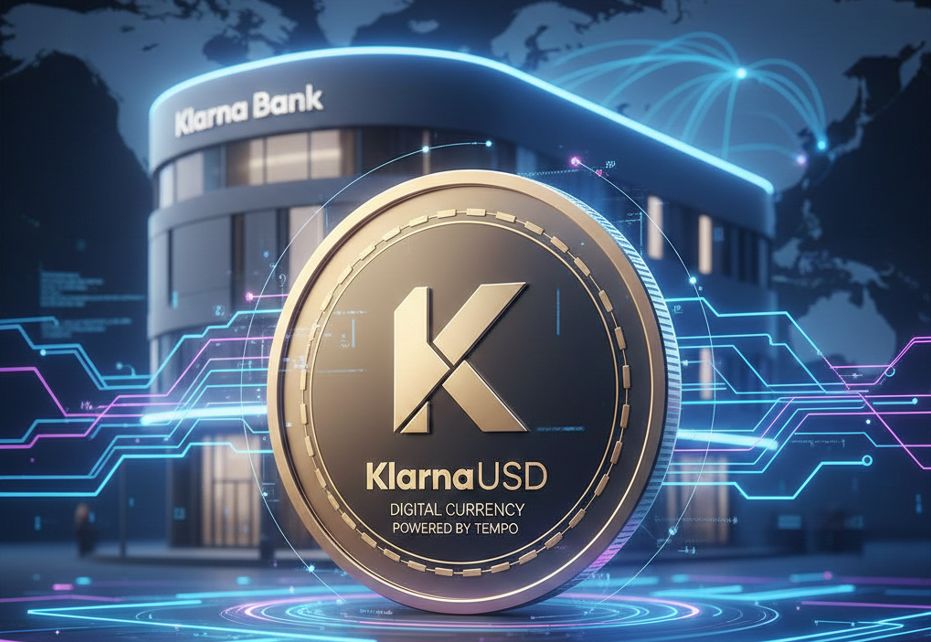
- Klarna launches KlarnaUSD, a USD-pegged stablecoin, on Stripe and Paradigm’s Tempo chain.
- KlarnaUSD targets cheaper cross-border payments before wider consumer rollout.
- Stablecoin market surges past $300B as major fintechs adopt blockchain rails.
Klarna has taken a major step into digital finance with the announcement of KlarnaUSD, a USD-pegged stablecoin built on Tempo, the new layer-1 blockchain developed by Stripe and Paradigm.
Introducing KlarnaUSD, our first @Stablecoin .
We’re the first bank to launch on @tempo , the payments blockchain by @stripe and @paradigm .
With stablecoin transactions already at $27T a year, we’re bringing faster, cheaper cross-border payments to our 114M customers.
Crypto is…
— Klarna (@Klarna) November 25, 2025
The move signals a decisive shift for the Swedish digital bank, which is preparing to integrate blockchain technology more deeply into its global payment systems.
Klarna steps into crypto
KlarnaUSD is now live on Tempo’s testnet, with a full mainnet rollout planned for 2026.
The stablecoin is issued through Bridge, Stripe’s dedicated stablecoin infrastructure product, giving Klarna a direct connection to one of the most advanced payment-focused blockchain stacks.
Notably, Klarna is the first financial institution to issue a token on Tempo, a blockchain engineered specifically for fast and low-cost payments.
Klarna explained that the token will first support internal payment flows.
The goal is to cut the cost of cross-border transfers, a persistent expense for global fintech companies.
After the mainnet rollout, the digital bank has signalled plans to extend KlarnaUSD to merchants and consumers after internal testing.
That expansion would build on Klarna’s broad checkout and instalment-payment network, though the firm says there are currently no plans to integrate the stablecoin into its buy now, pay later product.
Klarna’s push to cut global transfer costs
Klarna’s CEO, Sebastian Siemiatkowski, once sceptical of crypto, has now embraced blockchain’s potential in payments.
Siemiatkowski said that crypto has reached a stage where it is “fast, low-cost, secure, and built for scale,” describing KlarnaUSD as the beginning of a broader strategy.
With more than 114 million customers and $112 billion in annual gross merchandise volume, Klarna believes it has the scale to shift how global payments work.
The bank’s partnership with Stripe has been central to this push. Stripe already processes much of Klarna’s traffic, and Tempo provides the infrastructure for more efficient settlement.
Cross-border payments cost consumers and businesses around $120 billion each year, and KlarnaUSD is expected to cut a significant portion of these fees.
Early estimates across the industry suggest blockchain-based rails can reduce international payment costs by up to 90% compared to traditional networks.
Furthermore, KlarnaUSD’s launch comes at a moment when stablecoin usage is surging, with annual transaction volume already surpassing $27 trillion, according to McKinsey.
The global stablecoin market capitalisation has climbed from $260 billion in July to about $304 billion by November, with much of this growth coming after the passage of the US GENIUS Act, the first federal law governing stablecoins.
Treasury Secretary Scott Bessent expects stablecoins to reach a $3 trillion market cap by 2030, a scale that could save the US government $114 billion annually.
A market expanding at record speed
Other major companies are also entering the stablecoin arena.
MetaMask launched mUSD earlier this year, and Western Union plans to deploy a stablecoin on Solana in 2026.
Visa added support for the Global Dollar token and expanded settlement capabilities across Stellar and Avalanche.
The momentum suggests that stablecoins are becoming a central pillar in global financial infrastructure.
Klarna’s entrance adds another high-profile name to this growing list.
The bank recently listed on the New York Stock Exchange, raising $1.37 billion and reinforcing its financial position despite its stock hovering near 52-week lows.
Strong liquidity gives Klarna room to explore blockchain-based products, with executives hinting that more crypto-related projects are on the way.
As KlarnaUSD moves toward mainnet, eyes will be on how the firm integrates the token into its global operations.
If successful, KlarnaUSD may become one of the clearest examples yet of how established fintech companies can use blockchain to update old payment systems, and potentially redefine the future of cross-border money movement.


